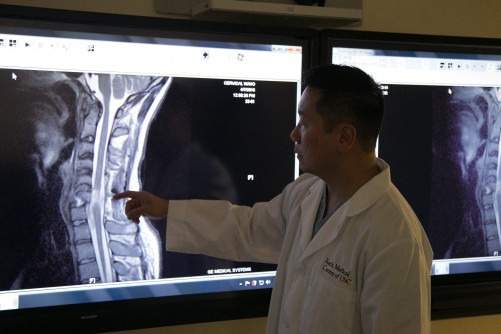
A team of doctors from Keck Medical Center of the University of Sourthern California (Los Angeles, USA) have become the first in the US state of California to inject an experimental treatment made from stem cells, AST-OPC1, into the damaged cervical spine of a recently paralysed 21-year-old man, as part of a multicentre clinical trial.
On March 6, 2016, Kristopher Boesen of Bakersfield, USA, suffered a traumatic injury to his cervical spine in a car accident. Physicians believed that permanent paralysis from the neck down was likely without intervention. However, Boesen qualified for the clinical trial.
Leading the surgical team and working in collaboration with Rancho Los Amigos National Rehabilitation Center and Keck Medicine of the University of Southern California, Charles Liu, director of the university’s Neurorestoration Center, injected an experimental dose of 10 million AST-OPC1 cells directly into Boesen’s cervical spinal cord in early April 2016.
“Typically, spinal cord injury patients undergo surgery that stabilises the spine but generally does very little to restore motor or sensory function,” explains Liu. “With this study, we are testing a procedure that may improve neurological function, which could mean the difference between being permanently paralysed and being able to use one’s arms and hands. Restoring that level of function could significantly improve the daily lives of patients with severe spinal injuries.”
Two weeks after surgery, Boesen began to show signs of improvement. Three months later, he is now able to able to feed himself, use his cell phone, write his name and operate a motorised wheelchair.
“As of 90 days post-treatment, Boesen has gained significant improvement in his motor function, up to two spinal cord levels,” says Liu. “In Boesen’s case, two spinal cord levels means the difference between using his hands to brush his teeth, operate a computer or do other things he would not otherwise be able to do. Having this level of functional independence cannot be overstated.”

Physicians are careful not to predict Boesen’s future progress.
The stem cell procedure Boesen received is part of a phase 1/2a clinical trial that is evaluating the safety and efficacy of escalating doses of AST-OPC1 cells developed by Asterias Biotherapeutics. AST-OPC1 cells are made from embryonic stem cells converted into oligodendrocyte progenitor cells.
In previous laboratory studies, AST-OPC1 have been shown to produce neurotrophic factors, stimulate vascularisation and induce remyelination of denuded axons. Edward D Wirth III, chief medical director of Asterias and lead investigator of the study, dubbed “SCiStar” says, “At the 10 million cell level, we are now in a dose range that is the human equivalent of where we were when we saw efficacy in pre-clinical studies.”
“While we continue to evaluate safety first and foremost, we are also now looking at how well treatment might help restore movement in these patients.”
Keck is one of six sites in the USA authorised to enrol subjects and administer the clinical trial dosage. The other SCiStar participating sites are: Indiana University in Indianapolis, Medical College of Wisconsin in Milwaukee, Rush University Medical Center in Chicago, Shepherd Center in Atlanta and Stanford University/Santa Clara Valley Medical Center in San Jose.
The first early data results from a group of patients in this study are expected to become available on September 14, 2016.











